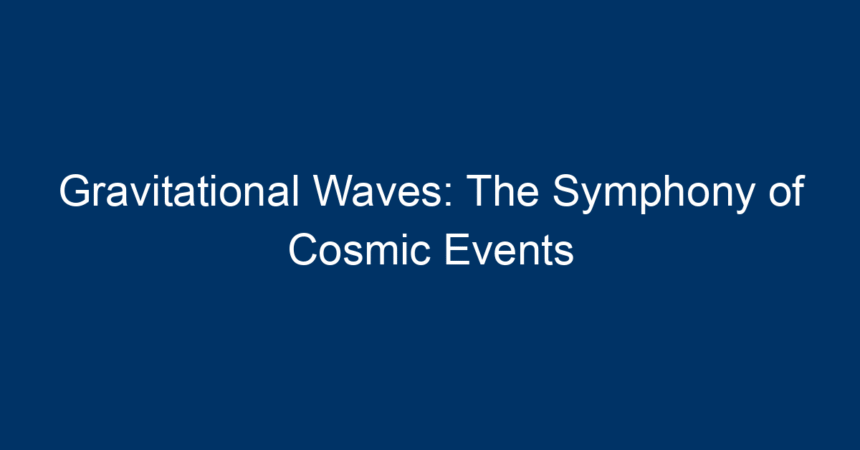Introduction
In the vast, mysterious cosmos, there are phenomena that remain enigmatic yet captivating to humankind. Among them are gravitational waves, ripples in the fabric of spacetime, created by some of the universe’s most dramatic events. First predicted by Albert Einstein in 1916 as part of his General Theory of Relativity, gravitational waves were confirmed only a century later. Their discovery in 2015 marked a revolutionary milestone in astrophysics, providing us with a new tool to understand the universe. This article will delve into the world of gravitational waves, exploring their origins, detection, significance, and the promising future they herald in astronomical research.
What Are Gravitational Waves?
Gravitational waves are disturbances in spacetime caused by accelerated masses, particularly involving massive astronomical bodies. When two black holes or neutron stars orbit each other and eventually merge, they create ripples that propagate through space. These waves travel at the speed of light, stretching and compressing the space around them as they go.
The frequencies of gravitational waves depend on the size of the event. For instance, merging black holes emit higher frequency waves compared to the lower frequency waves associated with massive cosmic events like supernova explosions. This variability opens a new window into the universe, allowing astronomers to observe celestial occurrences previously hidden from view.
The Historical Context of Gravitational Waves
Einstein’s predictions regarding gravitational waves initially seemed far-fetched, existing only in the realm of theoretical physics. It wasn’t until the 1990s that technology began to catch up with these revolutionary ideas. The Laser Interferometer Gravitational-Wave Observatory (LIGO) was established with the aim of detecting these elusive waves.
After years of research, on September 14, 2015, LIGO made history by detecting gravitational waves from the merger of two black holes, designated GW150914. This groundbreaking event confirmed Einstein’s century-old theory and opened a new field of study known as gravitational wave astronomy.
How Are Gravitational Waves Detected?
Detecting gravitational waves requires incredibly sensitive instruments. LIGO consists of two observatories located in the United States, one in Louisiana and the other in Washington state. Each observatory includes two long arms arranged in an L-shape. When a gravitational wave passes through, it alters the distance between the mirrors at the ends of the arms, creating a minuscule change that LIGO can measure.
LIGO uses a technology called laser interferometry. Essentially, lasers are fired down each arm, reflected back by mirrors, and then recombined. Any interference patterns caused by changes in distance due to passing gravitational waves reveal their presence.
In addition to LIGO, other observatories such as Virgo in Europe and the upcoming LISA (Laser Interferometer Space Antenna) aim to broaden our understanding by detecting waves from different cosmic events and at various frequencies.
The Significance of Gravitational Waves
Gravitational waves represent a new frontier in astronomy. They allow scientists to gather data about the universe’s most violent events—black hole mergers, neutron star collisions, and even supernovae—without the limitation of light. This new form of observation will transform our understanding of fundamental astrophysical processes.
-
Peering into Cosmic Catastrophes
Gravitational waves provide insight into the precise actions of massive objects colliding in space. By studying these waves, researchers can determine the masses, spins, and distances of the involved bodies. This data enriches our knowledge of the universe’s evolution and formation. -
Testing General Relativity
Every detection of gravitational waves serves as a test for Einstein’s theory. Each collision provides opportunities to validate or challenge existing theories about gravity, spacetime, and the fundamental forces of nature. - Multi-Messenger Astronomy
The intersection of gravitational waves with traditional electromagnetic signals (like light) enhances our understanding of astronomical events. For example, detecting a gravitational wave signal from a neutron star merger alongside gamma rays from the event allows for a multi-faceted analysis, leading to richer scientific insights.
Gravitational Waves and the Expansion of the Universe
Gravitational waves have implications beyond stellar phenomena. They may hold keys to understanding the expansion of the universe itself. Observing gravitational waves from distant galaxies provides information about cosmic distances and the rate of expansion, helping to clarify the mysteries of dark energy.
The Future of Gravitational Wave Astronomy
The future of gravitational wave astronomy is promising. Projects like LISA aim to detect lower-frequency waves from events not observable by LIGO and Virgo. The development of next-generation detectors, enhanced sensitivity, and expanded observatory networks will enable the detection of more subtle and distant events.
Moreover, international collaborations and advancements in technology will foster a more profound exploration of the universe. Scientists and astronomers are looking to the cosmos with renewed fervor, fueled by the discoveries made in the gravitational wave sector.
Conclusion: The Symphony of the Cosmos
Gravitational waves are more than just scientific phenomena; they are the universe’s haunting melodies, carrying stories of its most violent and awe-inspiring events. As we continue to refine our tools and techniques, we stand on the brink of a new era in astronomy—one where the sounds of the cosmos can be deciphered, revealing insights into the fabric of reality itself.
Actionable Insights
-
Stay Informed: Follow the latest research and discoveries related to gravitational waves through reputable sources like NASA, scientific journals, and institutions like LIGO.
-
Engage with Community: Join discussions in forums or social media groups focused on astrophysics and gravitational wave research to connect with like-minded enthusiasts.
-
Support Scientific Endeavors: Consider supporting or donating to research institutions dedicated to gravitational wave detection and education.
-
Explore Further: Deepen your understanding by reading books and taking online courses on gravitational waves, astrophysics, and general relativity.
- Become an Advocate: Help raise awareness about the significance of gravitational wave research in understanding our universe.
With every passing moment, the universe unfolds its secrets through the symphony of gravitational waves. Are you ready to tune in?




